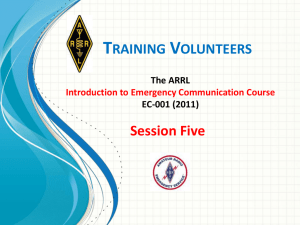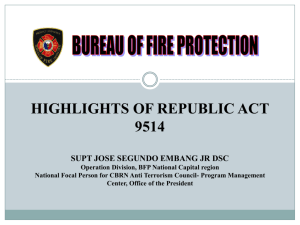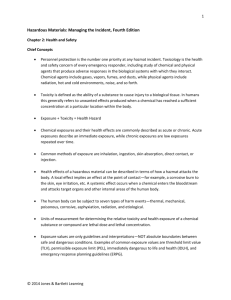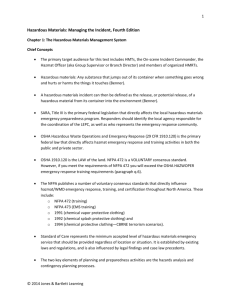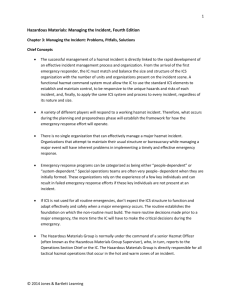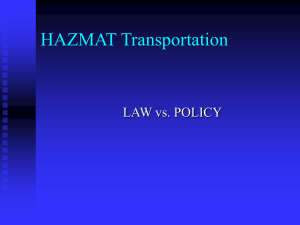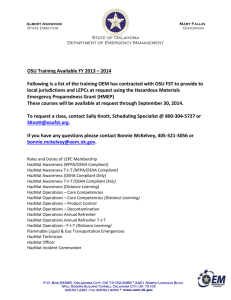Introduction to Hazardous Materials
advertisement
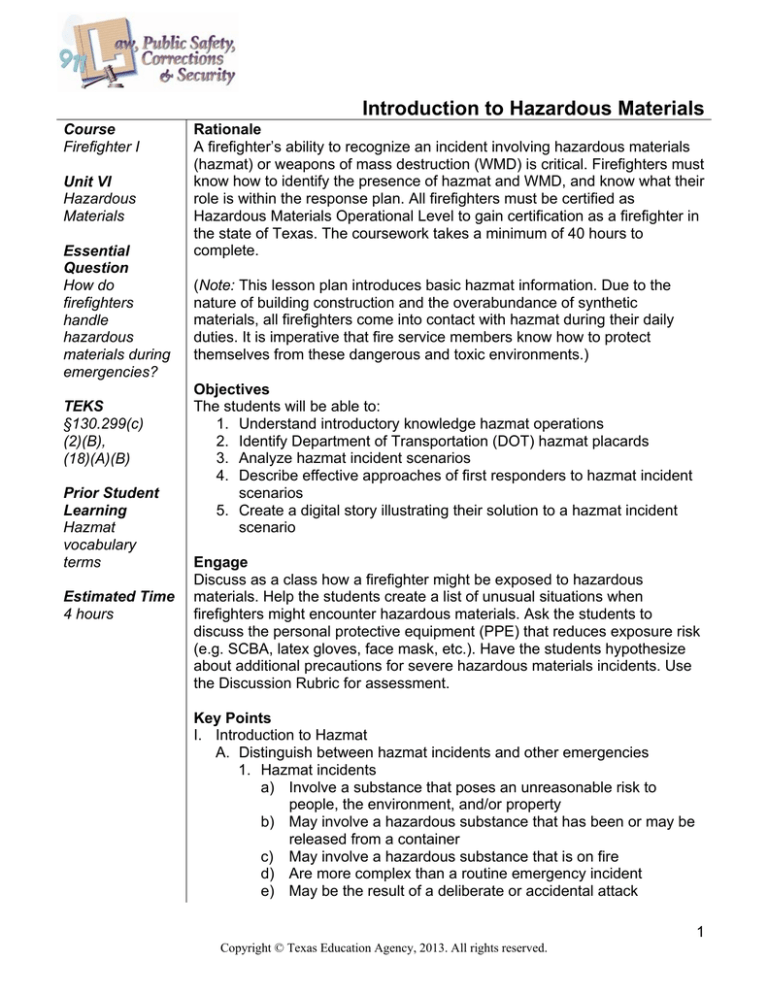
Introduction to Hazardous Materials Course Firefighter I Unit VI Hazardous Materials Essential Question How do firefighters handle hazardous materials during emergencies? TEKS §130.299(c) (2)(B), (18)(A)(B) Prior Student Learning Hazmat vocabulary terms Estimated Time 4 hours Rationale A firefighter’s ability to recognize an incident involving hazardous materials (hazmat) or weapons of mass destruction (WMD) is critical. Firefighters must know how to identify the presence of hazmat and WMD, and know what their role is within the response plan. All firefighters must be certified as Hazardous Materials Operational Level to gain certification as a firefighter in the state of Texas. The coursework takes a minimum of 40 hours to complete. (Note: This lesson plan introduces basic hazmat information. Due to the nature of building construction and the overabundance of synthetic materials, all firefighters come into contact with hazmat during their daily duties. It is imperative that fire service members know how to protect themselves from these dangerous and toxic environments.) Objectives The students will be able to: 1. Understand introductory knowledge hazmat operations 2. Identify Department of Transportation (DOT) hazmat placards 3. Analyze hazmat incident scenarios 4. Describe effective approaches of first responders to hazmat incident scenarios 5. Create a digital story illustrating their solution to a hazmat incident scenario Engage Discuss as a class how a firefighter might be exposed to hazardous materials. Help the students create a list of unusual situations when firefighters might encounter hazardous materials. Ask the students to discuss the personal protective equipment (PPE) that reduces exposure risk (e.g. SCBA, latex gloves, face mask, etc.). Have the students hypothesize about additional precautions for severe hazardous materials incidents. Use the Discussion Rubric for assessment. Key Points I. Introduction to Hazmat A. Distinguish between hazmat incidents and other emergencies 1. Hazmat incidents a) Involve a substance that poses an unreasonable risk to people, the environment, and/or property b) May involve a hazardous substance that has been or may be released from a container c) May involve a hazardous substance that is on fire d) Are more complex than a routine emergency incident e) May be the result of a deliberate or accidental attack 1 Copyright © Texas Education Agency, 2013. All rights reserved. 2. Other emergencies – do not involve the release of a hazardous substance B. Training requirements for awareness-level (hazmat) first responders 1. The Occupational Safety and Health Association (OSHA) and the US Environmental Protection Agency (EPA) require responders to meet specific training requirements 2. The US Department of Justice (DOJ) requires first responders to have training to prepare them for terrorist incidents involving weapons of mass destruction (WMD) 3. National Fire Protection Agency (NFPA) Standards a) NFPA 471: Recommended Practice for Responding to Hazardous Materials Incidents b) NFPA 472: Standard for Professional Competence of Responders to Hazardous Materials Incidents c) NFPA 473: Standard for Competencies for Emergency Medical Services (EMS) Personnel Responding to Hazardous Materials Incidents C. The primary responsibilities of an awareness-level responder at a hazmat incident 1. Recognize the presence or potential presence of hazmat 2. Recognize the container type and identify the material in it, if possible 3. Transmit information to the appropriate authority and call for assistance 4. Identify actions to protect oneself and others from the hazards 5. Establish control of the scene by isolating the hazardous area and denying entry D. The primary agencies that regulate hazmat 1. Department of Transportation (DOT) a) Issues transportation regulations for air space, highways, pipelines, railways, and waterways b) Enforces regulations at the federal, state, and local levels c) Defines when a material is considered hazardous d) Requires the use of placards during the transportation of hazmat (1) Placards – diamond-shaped signs attached to hazmat transportation vehicles that identify the following: (a) Explosive (orange) (b) Flammable or non-flammable gas (green or red) (c) Flammable combustible liquids (red) (d) Flammable solids (red candy-stripe or blue) (e) Oxidizers (yellow) (f) Poison (white) (g) Radioactive (yellow and white) (h) Corrosives (black and white) 2. EPA a) Researches and sets national standards for environmental programs 2 Copyright © Texas Education Agency, 2013. All rights reserved. b) Delegates the responsibility for issuing permits, monitoring, and enforcing the standards compliance of states and tribes c) Works with industries and government agencies for pollution prevention and energy conservation 3. Department of Labor (DOL) a) Includes OSHA b) Is responsible for overseeing US labor laws 4. Nuclear Regulatory Commission (NRC) a) Regulates US commercial nuclear power plants and the civilian use of nuclear materials b) Regulates the possession, use, storage, and transfer of radioactive materials E. Four products most often involved in hazmat incidents 1. Flammable/combustible liquids a) Petroleum products b) Paint products c) Resins d) Adhesives 2. Corrosives a) Sulfuric Acid b) Hydrochloric acid c) Sodium hydroxide 3. Anhydrous ammonia 4. Chlorine F. Hazard-control zones 1. Provide scene control to a) Protect first responders from interference by unauthorized persons b) Help regulate the movement of first responders within the zones c) Minimize contamination 2. Primary zone designations a) Hot zone (1) The area of greatest hazard at a hazmat incident site (2) No person should enter unless in approved PPE b) Warm zone (1) The area between the hot zone and the cold zone where danger exists but risk is limited (2) Responders may put on PPE and clean materials, if needed, but civilians and media are not allowed in this zone c) Cold zone (1) The outermost area of a hazmat incident site, which is considered uncontaminated (2) Special protective clothing measures are unnecessary in this zone G. General information about hazmat 1. Hazmat 3 Copyright © Texas Education Agency, 2013. All rights reserved. a) May be elements, compounds, or mixtures found in gaseous, liquid, or solid states, or a combination of these states b) May present a direct threat to health or be considered dangerous because of their physical hazards c) Range in severity from negligible to extremely dangerous (1) Non-flammable to extremely flammable (2) Non-reactive to highly reactive (i.e. detonate easily or unexpectedly) (3) Short-lived to multi-generational radioactive and biochemical effects 2. Types of exposures a) Acute (single occurrence) b) Chronic (reoccurring) 3. Types of health effects a) Acute – short-term effects that appear within hours or days (e.g. vomiting or diarrhea) b) Chronic – long-term effects that may take years to appear (e.g. cancer) 4. Behaviors of hazmat a) Depend upon a material’s (1) Physical state (2) Flammability (3) Boiling point (4) Chemical reactivity (5) Other properties b) Determine the type and amount of harm caused c) Influence the effects it has on containers, people, living organisms, other chemicals/materials, and the environment H. Potential ignition sources at a hazmat scene 1. Open flames 2. Static electricity 3. Pilot lights 4. Electrical sources 5. Internal combustion engines 6. Radiant heat 7. Cigarettes 8. Cameras 9. Road flares I. Categories of health and physical hazards 1. Thermal hazards a) Are related to temperature extremes b) Are caused by various factors such as (1) Hazmat (e.g. elevated-temperature materials or cryogenic liquids) (2) Conditions on the scene (e.g. extreme ambient air temperature) 2. Radiological hazards a) Exist in many forms, but ionizing radiation is the greatest 4 Copyright © Texas Education Agency, 2013. All rights reserved. concern for firefighters b) Usually exist for firefighters during incidents at specific types of locations, but they might also be used in terrorist attacks (1) Medical centers (2) Industrial operations (3) Nuclear power plants (4) Research facilities c) Usually pose minimal risks for firefighters if proper precautions, such as wearing PPE, are taken 3. Asphyxiation hazards a) Asphyxiants – substances that interfere with the oxygenation of the body and cause suffocation if untreated b) Two classes of asphyxiants (1) Simple asphyxiant – gases that dilute or displace the oxygen needed for breathing (2) Chemical asphyxiant – substances that prohibit the body from using oxygen 4. Chemical hazards a) May produce a wide range of effects whose likelihood and severity are contingent on the following factors (1) Chemical’s toxicity (2) Route of exposure (3) Nature and extent of exposure (4) Susceptibility of the exposed person b) Are classified as follows (1) Poisons/Toxic chemicals (2) Corrosives (3) Irritants (4) Convulsants (5) Carcinogens (6) Sensitizers/Allergens 5. Etiological/Biological hazards a) Are microorganisms that may cause severe disabling disease or illness, including (1) Viral agents (2) Bacterial agents (3) Rickettsias (4) Biological toxins 6. Mechanical hazards a) Can cause trauma as a result of direct contact with an object, usually striking or friction b) Can be mild, moderate, or severe c) Can result from a single event J. Routes of entry for human exposure to hazmat 1. Inhalation – breathing through the nose or mouth (e.g. smoke) 2. Ingestion – consuming through the mouth by a process other than inhalation (e.g. pill) 3. Injection – forcing through the skin by a puncture or break (e.g. 5 Copyright © Texas Education Agency, 2013. All rights reserved. syringe) 4. Absorption – assimilating through mucous membranes or areas of the body where skin is the thinnest (e.g. eyes) 5. Contact – occurs when a material touches skin or an exposed surface of the body (e.g. acid) Activities Incident Response Digital Story – Have students write a response to the short-answer questions (part 1: 55 pts.) and the incident scenarios (part 2: 45 pts.) on the Introduction to Hazardous Materials Short Answers and Scenarios Activity handout. Then have the students select and transform one of their scenario responses into a digital story (part 3) using the computer-based software of their choice. For assessment, use the Individual Work Rubric and the Introduction to Hazardous Materials Short Answers and Scenarios Activity Sample Answers. Assessments Introduction to Hazardous Materials Exam and Key Introduction to Hazardous Materials Key Terms Quiz and Key Introduction to Hazardous Materials Short Answers and Scenarios Activity Sample Answers Introduction to Hazardous Materials Department of Transportation (DOT) Placard Worksheet and Key Discussion Rubric Individual Work Rubric Materials Introduction to Hazardous Materials computer-based presentation Introduction to Hazardous Materials Key Terms Introduction to Hazardous Materials Short Answers and Scenarios Activity handout Introduction to Hazardous Materials Department of Transportation (DOT) Placard Worksheet and Key Computers with presentation or digital storytelling software Computers with Internet access Resources 0879393890, Hazardous Materials for First Responders. Oklahoma State University Fire Protection Pub; 4th edition. 2010 0879392568, Awareness Level Training for Hazardous Materials. Intl Fire Service Training Assn; 2nd edition. 2005 0135151112, Essentials of Firefighting and Fire Department Operations (5th Edition), International Fire Service Training Association (IFSTA), 2008. http://hazmatplacards.net/ Accommodations for Learning Differences For reinforcement, the students will conduct research and answer the questions on the Introduction to Hazardous Materials Department of 6 Copyright © Texas Education Agency, 2013. All rights reserved. Transportation (DOT) Placard Worksheet. (Note: A textbook or http://hazmatplacards.net/ may be used as a student resource.) Use the Introduction to Hazardous Materials Department of Transportation (DOT) Placard Worksheet Key for assessment. For enrichment, the students will select and research three toxic cleaning supplies. The students must find the material safety data sheets (MSDS) for each. (Note: The MSDS for most materials are available on the Internet.) Use the Individual Work Rubric for assessment. State Education Standards Texas Essential Knowledge and Skills for Career and Technical Education §130.299. Firefighter I (One to Two Credits). (2) The student executes safety procedures and protocols associated with fire management services. The student is expected to: (B) apply protocols for handling hazardous material; and (18) The student identifies safety procedures for ensuring a safe environment. The student is expected to: (A) identify protective equipment and describe its uses; (B) recognize traffic and scene control devices; College and Career Readiness Standards English/Language Arts Standards V. Research C. Produce and design a document. 1. Design and present an effective product. 2. Use source material ethically. 7 Copyright © Texas Education Agency, 2013. All rights reserved. Introduction to Hazardous Materials Key Terms Confinement – the procedures that keep hazmat in a specific area Containment – the process to keep hazmat in its container Cold zone – (a.k.a. support zone) the outermost area of a hazmat incident site, which is considered uncontaminated; special protective clothing measures are unnecessary in this zone Contaminant – a hazmat that physically remains on or in people, animals, the environment, or equipment and thereby creates a continuing risk of injury Hazard-control zones – provide scene control by designating zones at a hazmat incident based upon the degree of hazard (i.e. hot zone, warm zone, and cold zone) Decontamination – the physical and/or chemical process of reducing and preventing the spread of a contaminant from personnel and/or equipment used at a hazmat incident Environmental hazard – a condition capable of posing an unreasonable risk to air, water, or soil quality that directly impacts plants and/or wildlife Hot zone – (a.k.a. exclusion zone) the area of greatest hazard at a hazmat incident site; no person should enter unless in approved PPE Placards – diamond-shaped signs attached to hazmat transportation vehicles that identify the following: 1) Explosive (orange) 2) Flammable or non-flammable gas (green or red) 3) Flammable combustible liquids (red) 4) Flammable solids (red candy-stripe or blue) 5) Oxidizers (yellow) 6) Poison (white) 7) Radioactive (yellow and white) 8) Corrosives (black and white) Perimeter – the geographical boundary where access into an incident scene is restricted; responders are only allowed to enter if they have the required training Warm zone – (a.k.a. contamination reduction zone or corridor) the area between the hot zone and the cold zone where danger exists but risk is limited; responders can put on PPE and clean materials, if needed, but civilians and media are not allowed in this zone 8 Copyright © Texas Education Agency, 2013. All rights reserved. Introduction to Hazardous Materials Short Answers and Scenarios Activity Directions (Part 1): Answer the following short-answer questions and conduct research as needed. 1. Explain the following about protective equipment commonly used in hazmat incidents (12 pts.): a. Why is it needed? b. What types are available? c. What are the selection criteria? d. What are its limitations? 2. Name some of the hazards and limitations of using personal protective equipment (PPE) during hazmat incidents. (8 pts.) 3. What are some ways you can gauge the seriousness of a hazmat response? (10 pts.) 4. Describe the general aspects of the following in your own words (15 pts.): a. Control b. Containment c. Confinement 5. Explain some of the various decontamination procedures for victims, personnel, and equipment (10 pts.). Directions (Part 2): Imagine that you are an awareness-level responder in the following scenarios. Write a detailed description of how you would respond to each (15 pts. each). Scenario 1: You arrive on scene to an overturned 18-wheeler leaking an unknown substance. You see that the placard is solid orange, but you cannot read the words due to the smoke coming from the engine. What PPE do you need to handle this incident? What are the risks that you face? What safety precautions do you need to take to keep the situation as safe as possible? Scenario 2: You respond to a 911 call for a person experiencing difficulty breathing. When you arrive you find a man who appears to be 60 years old and homeless. The man is coughing continuously and exhibiting the symptoms of tuberculosis. How do you handle this situation? What PPE do you use to protect yourself against exposure? Scenario 3: A structure fire is reported at a one-story residence. When you arrive, you see that the front room is engulfed in flames. A neighbor states that the resident is a single woman who sleeps in the back bedroom and that her car is in the driveway. All of the information that you have suggests that she is still inside. Before you make entry what PPE would you need? Why? Directions (Part 3): Select one of your scenario responses and transform it into a digital story. The Individual Work Rubric will be used for assessment. 9 Copyright © Texas Education Agency, 2013. All rights reserved. Introduction to Hazardous Materials Short Answers and Scenarios Activity Sample Answers Part 1: Short Answers 1. Personal protective equipment (PPE) can range from latex gloves to a full “Level A” hazardous materials suit. Firefighting turnout gear and a self-contained breathing apparatus (SCBA) protect against toxic gases. Face masks, protective gowns, and safety glasses are also PPE commonly used by firefighters. Firefighters must analyze the incident to identify the risks and then choose the level of PPE that provides MORE security than they need. It is better to have too much protection than not enough. Every article of protective equipment has limits: fire-rated gear allows firefighters to be in high-temperature environments for only a few minutes before it loses effectiveness; latex gloves and body suits cannot withstand high temperatures; acids eat through almost all types of materials if given enough time. Every type of PPE has its limitations and those wearing it must be cautious to avoid exposing themselves to environments for which their gear is not rated. 2. Every article of protective equipment has its limits. Fire-rated gear only allows firefighters to be in high-temperature environments for a few minutes before it lose effectiveness. It is also bulky and difficult to move around in. It causes the wearer to get very hot and can only be worn for short periods of time. Latex gloves and body suits cannot withstand high temperatures and cause the wearer to sweat due to their inability to let moisture in or out. Acids eat through almost all types of materials if given enough time, and every car contains acid within its battery. Every type of PPE has its limitations and those wearing it must be cautious to avoid exposing themselves to environments for which their gear is not rated. 3. First, effectively size up the scene. What is involved? Can you see injured people? How many? What are the injuries? If fire is involved, how bad is the fire and are an appropriate number of firefighters currently responding to the incident? Can you tell what materials are involved by placards or Department of Transportation (DOT) numbers? If so, do you have access to the necessary material safety data sheets (MSDS)? If it is a gas, what way is the wind blowing? If it is a liquid, what direction is the leak flowing? How many people are downwind/downhill from the incident? Once you ask yourself these questions you can get the proper resources ordered to handle the event. Keep in mind that hazmat incidents are always changing, and it is important to constantly change your size-up as it progresses. What may have started as one type of incident can easily change to another. 4. a) Control – having an effective plan in place to deal with a hazmat incident while protecting citizens from injury and reducing damage to property b) Containment – keeping a material within its container or vessel c) Confinement – stopping a material from further leaking out of its container 5. Washing hands with soap and water; removing contaminated clothing when moving from the warm zone to the cold zone; Using 5-step hazmat decontamination pools/showers: 10 Copyright © Texas Education Agency, 2013. All rights reserved. o Step 1: remove personal belongings from the contaminated individuals o Step 2: remove clothing o Step 3: wash with soap for 1 to 3 minutes o Step 4: rinse o Step 5: don clean clothing Part 2: Scenarios Scenario 1: As a firefighter, I would wear full PPE (turnout gear with SCBA), stay upwind from the incident, and determine the contents of the truck before moving closer. A perimeter should be set to keep the general public away, and additional resources should be ordered if needed. Gas monitors should be used to test for air quality. Scenario 2: At any medical emergency I would wear general PPE precautions, including latex gloves. In the event a person appears to have a communicable disease, I would wear a face mask (N95 is best). Then I would place a mask on the individual who is sick to stop particulates from becoming airborne. If there is the risk that I might come into contact with blood or other bodily fluids, then I would wear a disposable gown. Scenario 3: If I need to enter a toxic atmosphere that contains fire, I would don both the standard fire turnout gear and an SBCA. This includes approved gloves, hood, helmet, and boots. I would also follow the mandatory two-in, two-out procedures. 11 Copyright © Texas Education Agency, 2013. All rights reserved. Name ________________________________ Date _________________________ Introduction to Hazardous Materials Department of Transportation (DOT) Placard Worksheet There are nine different DOT hazard classes. Please name them: 1. 2. 3. 4. 5. 6. 7. 8. 9. 10. Name one example of a hazardous material that must be placarded in any quantity. 11. What hazard class is the solid orange placard? 12. What hazard class is the solid blue placard? 13. What hazard class is the solid green placard? 14. An oxidizer is identified by what color/colors? 15. A corrosive is identified by what color/colors? 16. How many pounds of a class-2 materials legally require a placard? 17. Please draw the radioactive placard below. Be sure to include all required information. You may write in the color if you do not have all the colors you need. 12 Copyright © Texas Education Agency, 2013. All rights reserved. Introduction to Hazardous Materials Department of Transportation (DOT) Placard Worksheet Key 1. Explosives 2. Gas, non-flammable, oxygen, flammable gas, and poison gas 3. Flammable, combustible 4. Flammable solid, spontaneously combustible, and dangerous when wet 5. Oxidizer, organic peroxide 6. Poison and inhalation hazard 7. Radioactive 8. Corrosive 9. Not required for domestic transportation 10. Name one example of a hazardous material that has to be placarded in any quantity. Class/Table 1 must have a placard in any quantity. 11. Class 1 12. Class 4 13. Non-flammable gas 14. Yellow and black 15. Black and white 13 Copyright © Texas Education Agency, 2013. All rights reserved. Name ________________________________ Date _________________________ Introduction to Hazardous Materials Key Terms Quiz Directions: Match the term with the correct definition. 1. _____confinement 6. _____decontamination 2. _____containment 7. _____hot zone 3. _____cold zone 8. _____placard 4. _____contaminant 9. _____perimeter 5. _____hazard-control zones 10. _____warm zone **************************************************************************************************** A. The outermost area of a hazmat incident site, which is considered uncontaminated; special protective clothing measures are unnecessary in this zone B. The geographical boundary where access into an incident scene is restricted; responders are only allowed to enter if they have the required training C. Provide scene control by designating zones at a hazmat incident based upon the degree of hazard (i.e. Hot zone, warm zone, and cold zone) D. The physical and/or chemical process of reducing and preventing the spread of a contaminant from personnel and/or equipment used at a hazmat incident E. The procedures that keep hazmat in a specific area F. The area of greatest hazard at a hazmat incident site; no person should enter unless in approved PPE G. A hazmat that physically remains on or in people, animals, the environment, or equipment and thereby creates a continuing risk of injury H. Diamond-shaped signs attached to hazmat transportation vehicles that identify the type of hazmat contained in the vehicle I. The process to keep hazmat in its container J. The area between the hot zone and the cold zone where danger exists but risk is limited; responders can put on PPE and clean materials, if needed, but civilians and media are not allowed in this zone 14 Copyright © Texas Education Agency, 2013. All rights reserved. Introduction to Hazardous Materials Key Terms Quiz Key 1. E 2. I 3. A 4. G 5. C 6. D 7. F 8. H 9. B 10. J 15 Copyright © Texas Education Agency, 2013. All rights reserved. Name ________________________________ Date _________________________ Introduction to Hazardous Materials Exam 1. _____Which of the following is a true statement about hazmat incidents? A. Hazmat incidents are no more complex than routine incidents B. Governmental agencies are not involved in regulating hazmat C. Responders to hazmat incidents do not require any special training D. Hazmat incidents involve a substance that poses an unreasonable risk to people, the environment, and/or property 2. _____Which governmental agency requires responders to hazmat incidents to meet specific training requirements? A. Environmental Protection Agency (EPA) B. Federal Trade Commission (FTC) C. Bureau of Hazardous Materials (BHM) D. Consumer Product Safety Commission (CPSC) 3. _____Which NFPA standard applies to hazmat? A. NFPA 275 B. NFPA 351 C. NFPA 472 D. NFPA 1100 4. _____Which of the following is a primary responsibility of the awareness-level first responder? A. Implementing a plan of action B. Beginning offensive actions at the incident C. Recognizing the presence or potential presence of a hazmat D. Determining the extent of potential harm from the incident 5. _____Which of the following products are most likely to be involved in a hazmat incident? A. Plastics B. Synthetics C. Flammable/combustible liquids D. Organic solids 6. _____Which of the following factors has the greatest impact on the severity of a hazmat incident? A. Type and quantity of the material involved B. Location of the release C. Time of the release D. Speed of the release 16 Copyright © Texas Education Agency, 2013. All rights reserved. 7. _____Which of the following would be a potential ignition source at a hazmat incident? A. Synthetic clothing B. Road flares C. Debris D. Foam fire extinguishers 8. _____Which of the following describes the range of hazmat characteristics? A. Non-flammable to extremely flammable B. Non-reactive to highly reactive (i.e. detonate easily or unexpectedly) C. Short-lived to multi-generational radioactive and biochemical effects D. All of the above 9. _____Which of the following categories refers to harm from an exposure to a living microorganism? A. Etiological B. Thermal C. Radiological D. Chemical 10. _____Which of the following categories refers to harm from the result of extreme temperatures? A. Etiological B. Thermal C. Radiological D. Chemical 11. _____The behaviors of hazmat do not depend upon which of the following? A. Its physical state B. Its flammability C. Its chemical reactivity D. A firefighter’s readiness 12. _____Which of the following hazard-control zones is the area with the greatest hazard at a hazmat incident site? A. Cold zone B. Warm zone C. Hot zone D. The perimeter 13. _____A corrosive is classified as which of the following hazard types? A. Chemical B. Thermal C. Mechanical D. Biological 17 Copyright © Texas Education Agency, 2013. All rights reserved. 14. _____Which of the following routes of entry best describes the process that occurs when breathing in smoke? A. Absorption B. Inhalation C. Ingestion D. Injection 15. _____Which of the following routes of entry best describes the process that occurs when a person swallows a pill? A. Absorption B. Inhalation C. Ingestion D. Injection 16. _____Which of the following routes of entry best describes the process that occurs when a substance splashes into an eye? A. Absorption B. Inhalation C. Ingestion D. Injection 17. _____Which of the following routes of entry best describes the process that occurs when the skin is punctured by a syringe? A. Absorption B. Inhalation C. Ingestion D. Injection 18. _____Which of the following is “the physical and/or chemical process of reducing and preventing the spread of a contaminant from personnel and/or equipment used at a hazmat incident”? A. Decontamination B. Confinement C. Containment D. None of the above 19. _____Which of the following locations would most likely have a radiological hazard? A. Medical centers B. Nuclear power plants C. Research facilities D. All of the above 20. _____Which of the following requires the use of placards during transportation of hazmat? A. Occupational Safety and Health Association (OSHA) B. Department of Transportation (DOT) C. Environmental Protection Agency (EPA) D. None of the above 18 Copyright © Texas Education Agency, 2013. All rights reserved. 21. _____Which of the following are substances that prohibit the body from using oxygen? A. Simple asphyxiants B. Primary asphyxiants C. Chemical asphyxiants D. Organic asphyxiants 22. _____Which of the following does not determine the severity of a chemical hazard? A. Toxicity of the chemical B. Route of exposure C. Nature and extent of exposure D. Time of day 23. _____Which of the following refers to damage that occurs as a result of direct contact with an object? A. Radiological B. Thermal C. Mechanical D. Psychological 24. _____Which of the following should awareness-level first responders be able to recognize? A. Cost of containment B. Container type C. Extent of potential harm D. Behavior of material 25. _____Which of the following is a primary responsibility of an awareness-level first responder? A. Determining resources needed for an emergency B. Evaluating the response of all agencies involved C. Protecting nearby property from the effects of a release D. Transmitting information to an appropriate authority 26. _____Which of the following agencies has jurisdiction over the Occupational Health and Safety Administration (OSHA)? A. Department of Labor B. Department of Transportation C. Environmental Protection Agency D. Nuclear Regulatory Commission 27. _____The Environmental Protection Agency (EPA) is responsible for controlling radioactive materials. A. True B. False 28. _____Normal firefighter turnout gear is rated for hazmat incidents A. True B. False 19 Copyright © Texas Education Agency, 2013. All rights reserved. 29. _____Which of the following are etiological hazards? A. Viral agents B. Rickettsias C. Both A and B D. Neither A nor B 30. _____Which of the following describes the short-term health effects that appear within hours or days of exposure to hazmat? A. Acute B. Chronic C. Both A and B D. Neither A nor B 20 Copyright © Texas Education Agency, 2013. All rights reserved. Introduction to Hazardous Materials Exam Key 1. D 2. A 3. C 4. C 5. C 6. A 7. B 8. D 9. A 10. B 11. D 12. C 13. A 14. B 15. C 16. A 17. D 18. A 19. D 20. B 21. C 22. D 23. C 24. C 25. D 26. B 27. B 28. B 29. C 30. A 21 Copyright © Texas Education Agency, 2013. All rights reserved. Name_______________________________________ Date_______________________________ Discussion Rubric Objectives 4 pts. Excellent 3 pts. Good 2 pts. Needs Some Improvement 1 pt. Needs Much Improvement N/A Pts. Participates in group discussion Encourages others to join the conversation Keeps the discussion progressing to achieve goals Shares thoughts actively while offering helpful recommendations to others Gives credit to others for their ideas Respects the opinions of others Involves others by asking questions or requesting input Expresses thoughts and ideas clearly and effectively Total Points (32 pts.) Comments: 22 Copyright © Texas Education Agency, 2013. All rights reserved. Name______________________________________ Date_______________________________________ Individual Work Rubric 4 pts. Excellent Objectives 3 pts. Good 2 pts. Needs Some Improvement 1 pt. Needs Much Improvement N/A Pts. Follows directions Student completed the work as directed, following the directions given, in order and to the level of quality indicated Time management Student used time wisely and remained on task 100% of the time Organization Student kept notes and materials in a neat, legible, and organized manner. Information was readily retrieved Evidence of learning Student documented information in his or her own words and can accurately answer questions related to the information retrieved *Research/Gathering information (if relevant) Student used a variety of methods and sources to gather information. Student took notes while gathering information Total Points (20 pts.) Comments: 23 Copyright © Texas Education Agency, 2013. All rights reserved.
